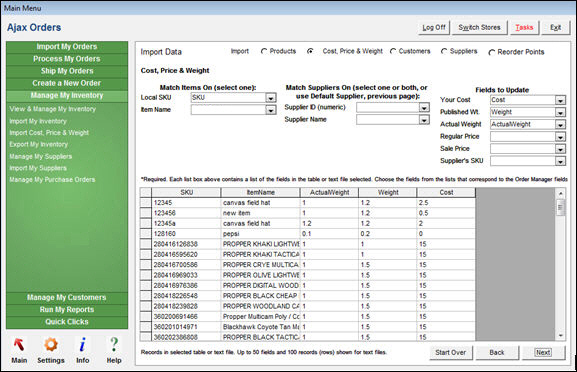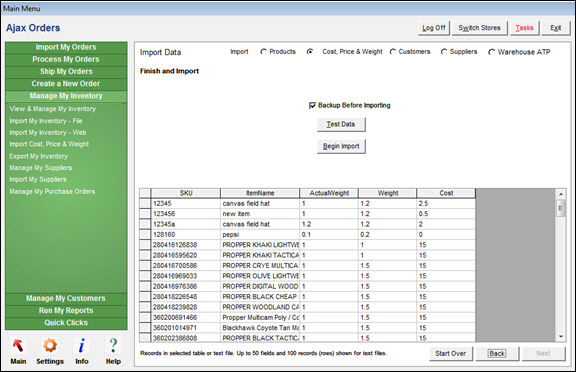Import Cost, Price and Weight
Contents of this Topic: ShowHide
Overview
This topic discusses the process of importing cost, price and weight
information for existing inventory items from a file, although several
types of data can be imported through the Import
Data screen. Customer, supplier and inventory reorder information
can also be imported via this screen as well.
Data can be imported from a tab or comma-delimited
text file. Importing data from an MS Access database is no longer supported.
When importing data from a text file and
the data contains commas, the file should be saved as a tab-delimited
file, not s a .csv file.
Quotes should not be present in text files,
regardless of whether it is a csv or tab-delimited file, or you will encounter
errors.
To import cost, price and weight information
for existing inventory items go to:
Main
Menu>Manage My Inventory>Import Cost, Price & Weight
Best Practice
Before importing data into the store file, make a backup copy in case
you need to back out the changes.
Description of the Screens
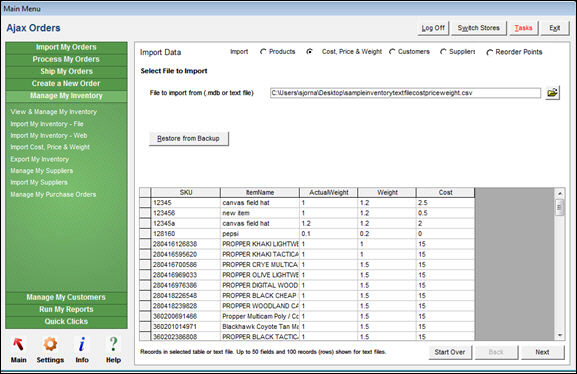
Import
Cost, Price, and Weight: Select File to Import tab
Select File to Import Tab
Import
- the Cost,
Price & Weight radio button is selected by default
File to import from text file
- enter the path to the file containing the
product information
- the program displays up to 50 fields in the
file and the first 100 records at the bottom of the screen
Folder
- select this button to navigate to the location
of the file containing the product information
Start Over
- returns to the Select
File to Import tab
Next
- select this when ready to proceed to the Import Options tab
Import Options tab
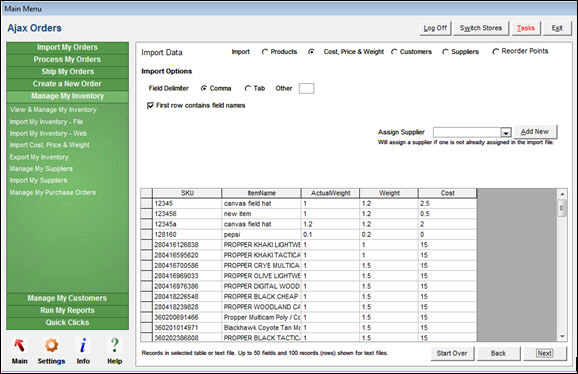
Import
Data screen: Import Options tab for importing Cost, Price, & Weight
information
Field Delimiter
Comma
- select this if the fields in the input file
are separated by commas
Tab
- select this if the fields in the input file
are separated by a tab
Other
- enter the character used to separate the fields
in the input file
First row contains field names
- select this if the first row in the input
file contains a header record with field names
Assign Supplier
- select a supplier to assign to product records
that do not already contain a Supplier ID or Supplier Name value
- this supplier automatically becomes the Primary
Supplier of the product
Add New
- select this to add a new supplier record "on
the fly"
Data in Text File
- this section displays up to fifty fields and
the first one hundred records of data in the input file
Start Over
- returns to the Select
File to Import tab
Back
- returns to the previous tab
Next
- select this when ready to proceed to the Cost, Price & Weight tab
Cost, Price & Weight tab
Match Items On (select one):
- choose whether to match product records between
the files based on the Local SKU
or Item Name
fields
- Local
SKU is the best choice because SKUs must be unique, whereas
products may share the same name
- clear the field that is not used
Match Suppliers On:
- select Supplier
ID and/or Supplier Name
OR leave these fields
blank and use the Supplier
specified on the previous tab instead
- Supplier
IDs in the external file must be numeric and they must be the
same Supplier IDs that exist
in Monsoon
Order Manager
Fields to Update
- select or clear the values in these drop-down
lists to control which fields are updated
- the possible choices are Your
Cost (supplier's unit cost field), Published
Wt., Actual Weight,
Regular Price,
Sale Price, or
Supplier's SKU
Data in Text File
- the grid at the bottom of the screen displays
up to fifty fields and the first one hundred records of data in the
input file (not labeled as such)
Start Over
- returns to the Select
File to Import tab
Back
- returns to the previous tab
Next
- select this when ready to proceed to the Pricing Fields tab
Pricing Fields tab
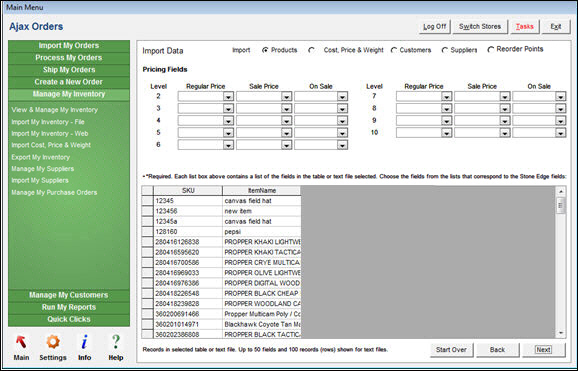
Import
Inventory screen: Pricing Fields tab
- map fields in the input file to fields in
Monsoon
Order Manager
if you use multi-level pricing
- refer to the Knowledge Base topic Price
Levels for more information
- select Next
to proceed to the Finish and
Import tab.
Finish and Import Tab
Disable Sync Database Triggers
- this box should be selected when initially
setting up the system since a provisioning event is used to communicate
product information to the Fulfillment Manager
- if you are importing product information after
production processing commenced, clear this box so the appropriate
Sync Manager messages are created and sent to the Fulfillment Manager
Test Data
- select this to have the program check for
errors before starting the import process
Begin Import
- select this to start the import process
Start Over
- returns to the Select
File to Import tab
Back
- returns to the previous tab
Additional information
Created:
6/15/12
Revised:
8/10/15
Published:
08/19/15




